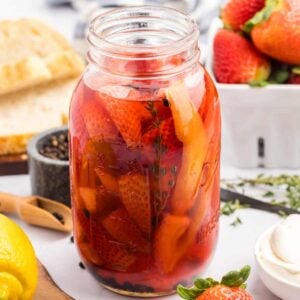How to Make Pickled Strawberries
No canning is required for these simple pickled strawberries; you just make a pickling liquid and pour it on top. If you know how to boil water, you can make this 😉. You might find, like us, that this is one of your favorite strawberry recipes of all.

If you’re not sure what to do with these, we love them on salads, served with cheese and crackers, and tucked into a grilled cheese sandwich. Sounds weird, I know. Give it a try anyway.
Ingredients and Tools You’ll Need
Like just about anything, it’s better with local, in-season produce. But I’m not a snob about it, and store-bought strawberries will still be good! And good news, no giant pots of boiling water are required. You’ll only need simple kitchen tools for this one.

Heart’s Content Farmhouse is a participant in the Amazon Services LLC Associates Program, an affiliate advertising program designed to provide a means for sites to earn advertising fees by advertising and linking to Amazon.com. This means that when you click on certain links on this site and make a purchase, I may earn a small commission at no additional cost to you. I only recommend products I genuinely believe in and would use in my own kitchen. As an Amazon Associate, I earn from qualifying purchases.
A Newsletter you’ll love
Daily recipes from the farmhouse, Sunday meal plans, seasonal ideas, straight from my kitchen to your inbox.
I promise to keep your email address safe. Unsubscribe at any time
Equipment
- 1 quart jar sterilized
- saucepan
- Knife and cutting board
Ingredients
- 1 pound fresh strawberries, hulled and halved
- 1 cup white balsamic vinegar (apple cider vinegar is an okay substitute, but really white balsamic is the best)
- ½ cup water
- ¾ cup sugar
- 1 teaspoon salt
- 1 teaspoon whole black peppercorns
- 2 sprigs fresh thyme
- 1 small cinnamon stick
- Zest of 1 lemon in large strips
How to Make Pickled Strawberries
Making this is easy since there is no canning. We’re essentially just boiling liquid and then refrigerating.
Step 1: Prep Strawberries
Wash the strawberries, hull, and cut them in half. If they are very large, you might have to cut them into quarters.

Step 2: Sterilize Jar
Make sure your quart jar is properly sterilized before using it to prevent any bacterial growth.
Step 3: Make Pickling Liquid
In a saucepan, combine balsamic vinegar, water, sugar, and salt. Bring to a boil, stirring to dissolve the sugar and salt.

Step 4: Add Spices
Once the sugar and salt have dissolved, add the peppercorns, fresh thyme, cinnamon stick, and lemon zest. Reduce the heat and simmer for 5 minutes to infuse the flavors.

Step 5: Assemble
Place the prepared strawberries into the sterilized quart jar. Carefully pour the hot pickling liquid over the strawberries in the jar, making sure the spices are distributed evenly. Leave about a half-inch of headspace at the top of the jar.

Step 6: Seal And Cool
Close the jar tightly with its lid. Let it cool to room temperature. Once cooled to room temperature, refrigerate the jar. Let the strawberries pickle for at least 4 hours before using them for the best flavor.

Step 7: Serve
Enjoy with salads, cheeses, or as a unique garnish for drinks and desserts.

Storage Instructions
These keep well in the fridge in terms of safety, but for the best taste, eat within a week. We like them best on day 2-4.
If you’re curious about the basics and safety of making refrigerator pickles in general, this is a good overview.
Refrigeration. Once the strawberries cooled to room temperature, store them in the refrigerator. Make sure you seal the jar . This will keep them fresh and flavorful for up to 2 weeks. For the best taste and texture, consume them within a week. They can become vinegary over time.
Avoid Room Temperature. Do not leave at room temperature for extended periods. This can speed up spoilage and bacterial growth.
Freezing: Freezing is not recommended. The freezing process can alter the texture of the strawberries. It makes them mushy when thawed. Additionally, the pickling liquid may not freeze well. This can lead to changes in flavor and consistency.
Check for Spoilage. Before consuming, always check for any signs of spoilage. These include an off smell, mold, or fermentation bubbles. If you notice any of these signs, it’s best to discard the pickles.
What to Serve with Pickled Strawberries
If a fresh strawberry or a pickle will work, try it! Here are some of the best ways:
- Pair with different cheeses and crackers for a unique charcuterie spread.
- Chop and toss them into a fresh green salad or a grain-based salad for a twist.
- Use a skewered pickled strawberry to garnish your favorite cocktails. It will work great with a strawberry peach sangria.
- Serve with grilled Huli Huli chicken
- Spread goat cheese or cream cheese on toast and top with pickled strawberries for a quick snack.
- Add it to a turkey or ham wrap for a surprising burst of flavor.
- Chop and sprinkle over strawberry ice cream or yogurt.
Questions and Troubleshooting
It’s best to use fresh strawberries for pickling. Frozen strawberries tend to become mushy when thawed.
Yes, you can reduce the sugar according to your taste preference. It will still be safe. But honestly, they aren’t overly sweet and the recipe needs the sugar!
At least 4 hours. But, waiting a day or two can enhance the flavors even more.

More Ways to Preserve Strawberries:
Strawberries are a favorite around here, and when it’s strawberry season, we get to work! Here are some of our favorite ways to use them.
- Another simple, no-canning way to preserve is oven-dried strawberries.
- But if you are ready to can, you’ll love having strawberry preserves on your morning toast.
- Or try canning strawberry syrup to pour over pancakes or use to make cocktails.
- Try your hand at making strawberry ice cream. Everyone should try it at least once!
Printable Recipe
Pickled Strawberries

Equipment
- 1 quart jar sterilized
- saucepan
- Knife and cutting board
Ingredients
- 1 pound fresh strawberries hulled and halved
- 1 cup white balsamic vinegar
- ½ cup water
- ¾ cup sugar
- 1 teaspoon salt
- 1 teaspoon whole black peppercorns
- 2 sprigs fresh thyme
- 1 small cinnamon stick
- Zest of 1 lemon in large strips
Save This Recipe
You'll join my email list which you will love. And if you don't, unsubscribe in one click. ❤️
Instructions
- Prep strawberries. Wash the strawberries, hull, and cut them in half. If they are very large, you might have to cut them into quarters.
- Sterilize jar. Make sure your quart jar is properly sterilized before using it to prevent any bacterial growth.
- Make pickling liquid. In a saucepan, combine balsamic vinegar, water, sugar, and salt. Bring to a boil, stirring to dissolve the sugar and salt.
- Add spices. Once the sugar and salt have dissolved, add the peppercorns, fresh thyme, cinnamon stick, and lemon zest. Reduce the heat and simmer for 5 minutes to infuse the flavors.
- Assemble. Place the prepared strawberries into the sterilized quart jar. Carefully pour the hot pickling liquid over the strawberries in the jar, making sure the spices are distributed evenly. Leave about a half-inch of headspace at the top of the jar.
- Seal and cool. Close the jar tightly with its lid. Let it cool to room temperature. Once cooled to room temperature, refrigerate the jar. Let the strawberries pickle for at least 4 hours before using them for the best flavor.
- Serve. Enjoy your pickled strawberries with salads, cheeses, or as a unique garnish for drinks and desserts.
Notes
Nutrition
Love,










